Biological control Part II: Our favorite natural enemies
In this Biological control Part II, we will familiarize you with these natural enemy allies found in Wisconsin. For a summary of biocontrol, please read part I of this series (Biological control Part I), where we introduced the concept of biocontrol, considered different types of biocontrol strategies, and discussed the advantages and difficulties of integrating biological control into an IPM management plan. To recap, biological control, which is the reduction of a pest population by natural enemies due to human intervention, is carried out by a host of allies including predacious flies, bugs and beetles, parasitoid wasps and flies, mites, pathogens and nematodes.
Ladybeetles (order Coleoptera, family Coccinellidae) are very important biological control agents against soft-bodied insect pests, such as aphids. Being predacious throughout their life, each ladybeetle larva consumes hundreds to thousands of pests during its development, and their ability to increase population size rapidly to keep up with pest outbreaks makes them very good natural enemies. Ladybeetle larvae are alligator-shaped and very mobile (see photo to the left). The eggs are bright yellow clumps of ovular eggs, usually laid on the underside of leaves.
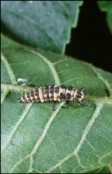
Ladybeetle larva. Photo by Bugwood org. 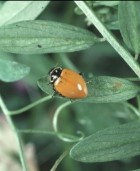
Ladybeetle adult. Photo by Bugwood.org
There are many species of ladybeetle native to Wisconsin, and more that have been introduced specifically to control insect pests. It’s worth mentioning here the multicolored Asian ladybeetle, which can be a pest in the fall when adults feed on wine grapes and congregate in houses. Although this species can be pestiferous, it is also beneficial throughout much of its life, and can be a great natural enemy in some cropping systems such as soybean. Other species of ladybeetle are available commercially for augmentative biocontrol. The black ladybeetle called spider mite destroyer (Stethorus punctum) is a valuable natural enemy for pest mites, and is resistant to some organophosphates.
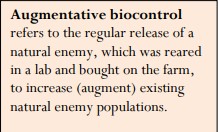
Lacewing larvae (order Neuroptera) are voracious predators that feed mainly on aphids, but also on scale insects, leafhoppers, mites, caterpillar eggs and pear psylla. The larvae are also alligator-shaped and feed using their hollow sickle-shaped mandibles, which they pinch into their prey and suck out their innards (see at photo). Lacewing eggs are easy to recognize as each egg is laid on a threadlike stem, raising it up in the air to prevent early-hatching voracious larvae from feeding on their siblings! Each lacewing larva can eat up to 600 aphids during its development. Because lacewing larvae are active earlier in the season than many other predators, they are often used against early-season pests. Their eggs can be purchased for augmentation biocontrol, or the mobile adults can be encouraged to lay eggs on your property by providing them with floral nectar resources.
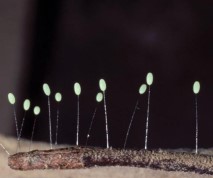
Lacewing eggs. Photo by Bugwood.org 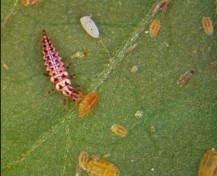
Lacewing larva feeding on aphids. Photo by Bugwood.org.
Minute pirate and other predacious bugs (order Hemiptera) are related to stink bugs and aphids, and similarly feed using a piercing sucking “beak”, but suck the juices out of pest insects instead of your crops. There are a few species of predacious bugs within this group, which feed mainly on softbodies insects like aphids, spider mites, and the eggs of many pest insects. Anthocoris nemoralis is a European species that has been imported to control pear psylla. Orius spp. are native and can be abundant in Wisconsin fruit crops. They are predaceous as both adults and immatures.
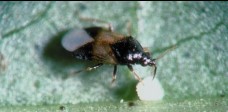
A convenient aspect of predacious bugs is that, when prey are not present, they can subsist by feeding on plant juices (although they may feed on your crops, they do not cause any economic damage). This means they can survive even when pest populations are low, and so can maintain pests at a lower density than can many other natural enemies. Because of this tendency to occasionally feed on plant tissue, predatory bugs are extremely susceptible to pyrethroid and other insecticides.
Predacious flies (order Diptera, families Syrphidae and Cecidomyiidae) feed mainly on aphids. Syrphids are especially important natural enemies in the fall, since their predaceous larvae thrive in cooler temperatures than many other aphid predators. The larvae are legless and feed using a triple-pointed hook-like mouthpart. The adults look somewhat similar to bees, but with large fly-eyes and only one pair of wings; a common name of the “hoverfly” comes from their ability to hover in place above flowers and when looking for mates. They do not sting. Although syrphids are predaceous only as larvae, the adults are also beneficial in that they serve as excellent pollinators.
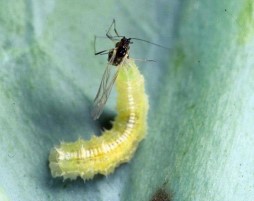
Cecidomyiid fly larvae are conspicuously bright orange colored, and also feed on aphids, as well as mites, scale insects, and mealybug eggs. Although only a few species of cecidomyiid fly larvae feed on our pests (the others cause galls in various species of plant), those that do are valuable allies. They feed from June through late summer, and are available commercially for augmentative biocontrol. They are especially important in conventional farming systems, since they show partial resistance to some broad-spectrum insecticides.
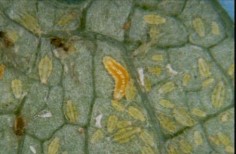
Parasitoid wasps (order Hymenoptera, families Trichogrammatidae, Ichneumonidae, Braconidae, and more), like other parasitoids, develop inside (endoparasitoids) or attached to the outside of their hosts (ectoparasitoids), feeding on the host and thus killing the host before emerging. If you’re having visions of the movie Alien, that’s because the concept for the aliens in that movie was based on the parasitoid life history. Luckily there are no vertebrate parasitoids!
Trichogrammatid wasps are among the smallest parasitoids, generally developing inside the eggs of other insects, often Lepidoptera (moths and butterflies). Historically, they have been used to control codling moth and leafrollers, although results have not been definitively successful. Some challenges to the use of these tiny parasitoids include that they may be generalist feeders, they need to be present in very high numbers to maintain pests below economic levels, and are extremely susceptible to even the softer insecticide chemistries.
The aphelinid wasps are tiny parasitoid wasps often used to control aphids and scale insects. For example, Aphelinus Mali, when plentiful, can control populations of wooly apple aphid. Some species of aphelinids are available commercially.
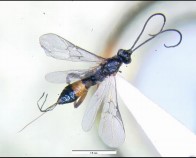
Ichneumonid and braconid wasps are abundant and speciose, with 120,000 known species in the world and probably many others that have not yet been described. Because of this diversity, there is a potential for untapped biocontrol resources in this group. Historically, parasitoid wasps have been known to effectively control fruit pests’ populations, especially of Lepidopteran pests, in low- or no-spray situations. However, with the large numbers of pests present in most of our fruit crops, and the greater number of insecticide applications necessary on a yearly basis, parasitoid wasps have ceased to be a regularly important factor in most biocontrol programs. However, with increasing emphasis on IPM programs, it is likely their use will increase in the coming years.
Parasitoid flies (order Diptera, family Tachinidae) are all endoparasitoids, feeding entirely inside of their hosts. The over 1,000 species of tachinid flies found in North America often have relatively polyphagous feeding habits, and, between them, can provide biocontrol of pest moths, beetles, sawflies and stink bugs. You may be able to recognize tachinid flies on your pests in two ways: some species lay their white eggs directly onto the body of the pest, and often the fly will pupate nearby to the dead pest carcass. Adult tachinid flies look like bristly houseflies, and are difficult to distinguish without magnification. Further research could help clarify the efficacy of tachinid fly species at controlling our pest populations.
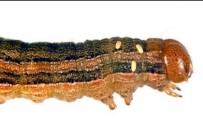
Predacious mites (Acari subclass, family Phytoseiidae and more) feed on pest mites, such as spider mites, as well as eggs and immature scale insects, thrips, and other small insects. As a reminder, mites are not insects, they are more closely related to ticks and spiders, but can be significant pests of fruit crops. The many species of predacious mites are, despite their small size, potentially important biocontrol agents in Wisconsin. Some can be purchased for augmentative biocontrol, while many others are naturally occurring and can be conserved by providing habitat and minimizing broad-spectrum insecticides.
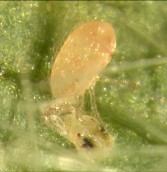
Spiders (order Araneae) are abundant and diverse predators. Their diet is generally polyphagous, meaning they are likely to feed on not only your pests, but also on beneficial and other insects on your property. Because there are so many species of spiders, they can fit into nearly any natural enemy niche available, feeding on many different pest species, in the canopy as well as at ground level, and throughout the growing season. Some (including jumping spiders and wolf spiders) actively hunt their prey, others (including crab spiders and lynx spiders) sit and wait for prey to run by, and another group (including orb weavers) catch prey in their webs. Spiders are very sensitive to broad-spectrum insecticides, so reducing insecticide applications is the best way to increase spider populations.
Pathogens that attack and control fruit pests include bacteria, viruses and fungi. Many of these are naturally present in the environment, and some are available commercially. These are commonly used in organic agriculture. Many are relatively host-specific, which helps reduce toxicity to beneficials, but also require a good degree of understanding of the pests and agroecosystem to be effective requires an understanding. For example, the commonly used bacterial insecticide Bacillus thuringiensis (Bt) offers control against different orders of pest insect depending on the subspecies of Bt is being used – Btk is primarily effective against butterfly and moth caterpillars while Bti is effective against flies. Fungi and viruses are available for many common fruit pests, including codling moth and some species of aphid, thrips, and weevils.
More information about natural enemy species can be found on the following online resources:
Beers, E., J. F. Brunner, M. J. Willett and G. Warner. Orchard Pest Management Online. Washington State University.
Biddinger, D. (2017). Natural Enemies/Biological Control in Orchards. Penn State University Extension.
Dreistadt, S. H. (2014). Biological Control and Natural Enemies of Invertebrates: Integrated Pest Management for Home Gardeners and Landscape Professionals. University of California, Davis, Agriculture and Natural Resources.
This article was posted in Insects.
